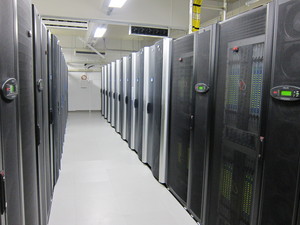NEW ORLEANS, LA--(Marketwire - November 18, 2010) - SC10 -- The "Green500" list of the world's most energy-efficient supercomputers was released today, revealed that the only petaflop system in the top 10 is powered by NVIDIA® Tesla™ GPUs.
The system was Tsubame 2.0 from Tokyo Institute of Technology (Tokyo Tech), which was ranked number two.
"The rise of GPU supercomputers on the Green500 signifies that heterogeneous systems, built with both GPUs and CPUs, deliver the highest performance and unprecedented energy efficiency," said Wu-chun Feng, founder of the Green500 and associate professor of Computer Science at Virginia Tech.
GPUs have quickly become the enabling technology behind the world's top supercomputers. They contain hundreds of parallel processor cores capable of dividing up large computational workloads and processing them simultaneously. This significantly increases overall system efficiency as measured by performance per watt. "Top500" supercomputers based on heterogeneous architectures are, on average, almost three times more power-efficient than non-heterogeneous systems.
Three other Tesla GPU-based systems made the Top 10. The National Center for Supercomputing Applications (NCSA) and Georgia Institute of Technology in the U.S. and the National Institute for Environmental Studies in Japan secured 3rd, 9th and 10th respectively. Tesla GPU-based systems also secured 11th, 12th and 13th; CSIRO in Australia, Tianhe-1A in Tianjin and Nebulae in Shenzhen, China.
The complete Top 10 list (with Tesla GPU-powered systems in bold face):
| Rank | Site | Linpack Perf. | # of Tesla GPUs | Megaflops per watt |
| 1 | IBM Research | 653 Teraflops | n/a | 1684 Mflops/watt |
| 2 | GSIC Center, Tokyo Tech | 1.192 Petaflops | 4200 | 948 Mflops/watt |
| 3 | NCSA | 33.6 Teraflops | 128 | 933 Mflops/watt |
| 4 | RIKEN AICS | 58 Teraflops | n/a | 828 Mflops/watt |
| 5 | Forschungszentrum Juelich | 45 Teraflops | n/a | 773 Mflops/watt |
| 6 | Universitaet Regensburg | 45 Teraflops | n/a | 773 Mflops/watt |
| 7 | Universitaet Wuppertal | 45 Teraflops | n/a | 773 Mflops/watt |
| 8 | Universitaet Frankfurt | 94 Teraflops | n/a | 741 Mflops/watt |
| 9 | Georgia Institute of Technology |
64 Teraflops | 360 | 677 Mflops/watt |
| 10 | National Institute for Environmental Studies | 74.84 Teraflops | 320 | 636 Mflops/watt |
Many of the leaders of those supercomputing centers recognized by the Green500 organization are present this week at the SC10 conference in New Orleans. They made the following comments:
Quotes:
Prof. Satoshi Matsuoka of Tokyo Tech said: "Our goal with Tsubame 2.0 was to deliver petaflop performance in as small a power envelope as possible. Moving to Tesla-based GPU supercomputers was the only way to achieve this."
Dr. Jeffrey Vetter of Georgia Tech and Oak Ridge National Laboratory said: "Keeneland is a proving ground for software development spanning research and industry. Through its use of GPUs and heterogeneous architectures, we are paving the way to energy-efficient exascale computing."
Dr. Gareth Williams of Australia's CSIRO said: "With the help of GPUs, we have succeeded in developing the fastest, most efficient supercomputer in Australia. With this kind of computational resource, we will be able to dramatically advance the pace of our research."
"The high performance per watt of Tesla GPUs has made them the architecture of choice for modern supercomputing, as evidenced by GPU supercomputers being the only petaflop-capable systems in the Top 10," said Andy Keane, general manager, Tesla business at NVIDIA. "We congratulate all the centers that have been recognized for their work in this year's Green500."
Weblinks to:
More information on NVIDIA Tesla high performance GPU computing products
Green500 site: http://www.green500.org/home.php
CSIRO "Green500" video: http://www.youtube.com/watch?v=BV5cSswg9uE
Impressions from SC10 by Steve Keckler, NVIDIA Research: http://cacm.acm.org/blogs/blog-cacm/101867-sc10-dally-keynote-heterogeneous-computing-systems/fulltext
About NVIDIA
NVIDIA (
Certain statements in this press release including, but not limited to, statements as to: the benefits and impact of NVIDIA Telsa GPUs; and the impact of the company's patents on modern computing; are forward-looking statements that are subject to risks and uncertainties that could cause results to be materially different than expectations. Important factors that could cause actual results to differ materially include: our reliance on third parties to manufacture, assemble, package and test our products; global economic conditions; development of faster or more efficient technology; the impact of technological development and competition; design, manufacturing or software defects; changes in consumer preferences or demands; changes in industry standards and interfaces; unexpected loss of performance of our products or technologies when integrated into systems; as well as other factors detailed from time to time in the reports NVIDIA files with the Securities and Exchange Commission, or SEC, including its Form 10-Q for the fiscal period ended August 1, 2010. Copies of reports filed with the SEC are posted on the company's website and are available from NVIDIA without charge. These forward-looking statements are not guarantees of future performance and speak only as of the date hereof, and, except as required by law, NVIDIA disclaims any obligation to update these forward-looking statements to reflect future events or circumstances.
© 2010 NVIDIA Corporation. All rights reserved. NVIDIA, the NVIDIA logo, and Tesla, are trademarks and/or registered trademarks of NVIDIA Corporation in the U.S. and other countries. Other company and product names may be trademarks of the respective companies with which they are associated. Features, pricing, availability, and specifications are subject to change without notice.
Contact Information:
For more information, contact:
Andrew Humber
NVIDIA Corporation
(408) 416 7943
ahumber@nvidia.com

